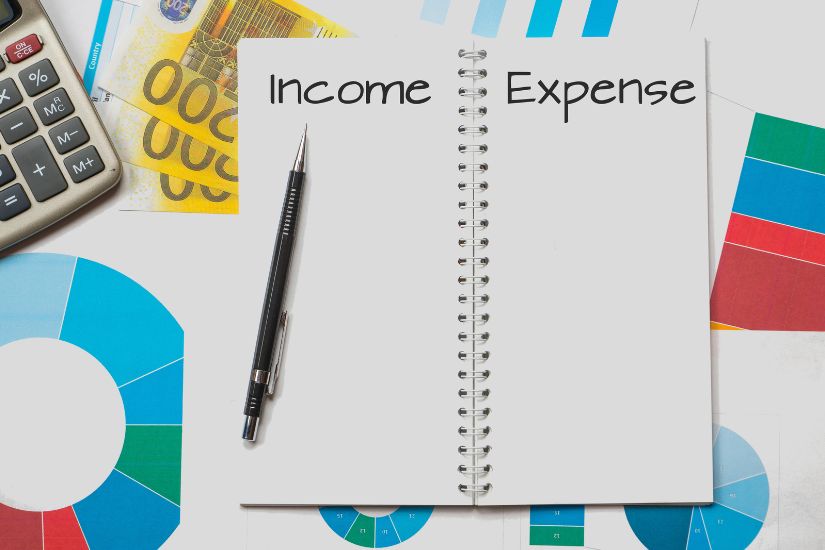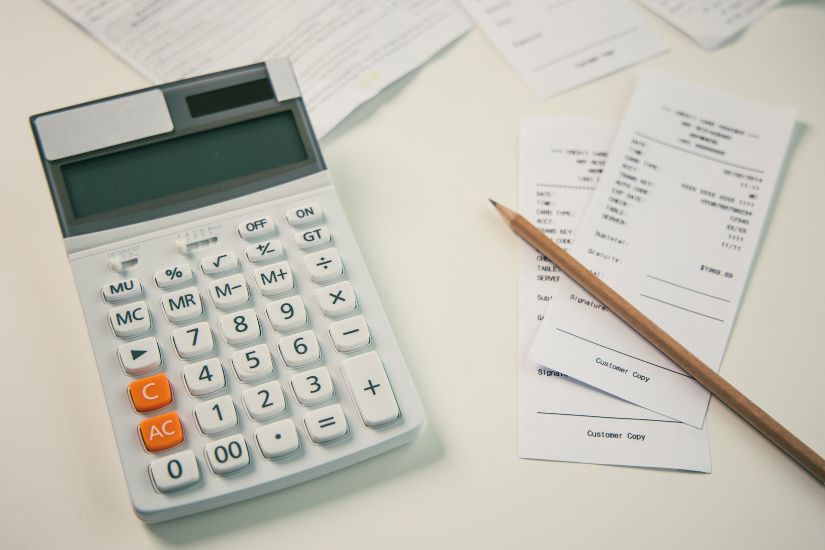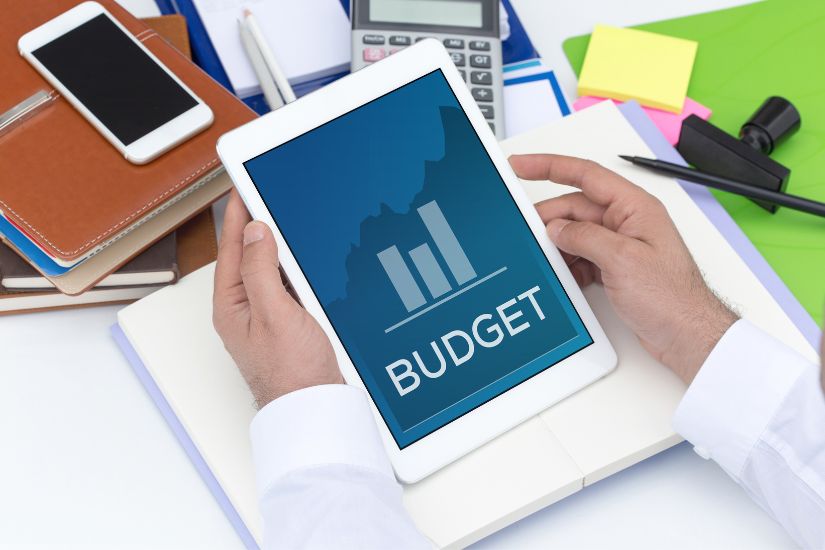This post may contain affiliate links. Please read my disclaimer for more information.
Simplify Your Finances & Build Wealth with Ease!
Take control of your money without stress or overwhelm. Download The 5-Step Minimalist Money Plan now and start saving, investing, and growing your wealth—effortlessly! 🚀💰
A budget is one of my favorite financial topics, and to be honest, I am a bit obsessed with it. It is an underrated and often misunderstood financial tool that can have a significant impact on any woman’s financial situation, regardless of her current status. I’m passionate about showing how a budget can transform your financial life and improve your relationship with money. A budget is more than just tracking expenses; it’s a powerful tool for fostering mindfulness and control over your finances. I am not only going to show you how to make a budget that works for you, but also how it can change your financial life in the long term.
So let’s summarize for short: Managing your finances effectively is crucial for achieving financial stability, security and reaching your financial goals. Creating a budget is a foundational step in money management that helps you understand your income, control your expenses, and save for the future.
My comprehensive guide will walk you through the process of making a budget that works for you, covering the essential steps and strategies to ensure you can stick to it and achieve financial success.
The Importance of Money Management
As I mentioned in a further post, I believe there are three key things that are essential to building a solid financial life. The first is a good attitude and relationship with money; the second is financial planning; and the third is good money management.
Money management is the cornerstone of financial well-being. It involves planning, organizing, and controlling your financial activities to maximize the use of your income.
Effective money management can help you:
- Avoid debt and financial stress.
- Save for emergencies and future goals.
- Make informed financial decisions.
- Achieve financial independence and security.
Without proper money management, it’s easy to fall into the trap of living paycheck to paycheck, accumulating debt, and feeling overwhelmed by financial pressures. By learning how to make a budget and manage your money wisely, you can take control of your financial future.
👉 Read more: Transform Your Wealth Mindset: Powerful Habits for Financial Success and Security
Understanding Your Income and Expenses
The first step in creating a budget is to understand your income and expenses. This involves tracking all sources of income and categorizing your expenses to see where your money is going.
Income
Since your budget will be based on your income, you need to know your total income and everything. And by “everything” I mean everything that comes into your household as money that you can spend, no matter where it comes from.
Therefore, start by listing all sources of income, including:
- Salary or wages.
- Freelance or side job earnings.
- Investment income.
- Rental income.
- Any other sources of regular income.
If you have an irregular income, base your income on your lowest-paying month from the previous year! I call this “figuring out your minimum.”
Expenses
Next, categorize your expenses into fixed and variable categories:
- Fixed Expenses: These are regular, recurring expenses that remain relatively constant each month. They are easy to calculate. Examples include:
- Rent or mortgage payments.
- Utilities (electricity, water, internet).
- Insurance premiums.
- Loan repayments.
- Variable Expenses: Variable costs are costs that can vary from month to month, but often remain within the same range. They may be a little more difficult to calculate at this point, but not impossible. Examples include:
- Groceries.
- Transportation (gas, public transit).
- Entertainment and dining out.
- Clothing and personal care.
- Miscellaneous purchases.
By understanding your income and expenses, you can identify areas where you might be overspending and find opportunities to save.
Evaluate Your Financial Goals
Once you have a clear picture of your income and expenses, I suggest you evaluate your financial goals.
Why?
The answer is simple: Setting specific, measurable, achievable, relevant, and time-bound (SMART) goals will provide direction and motivation for your budgeting efforts. Keeping your goals in mind when creating your budget will help you allocate your money easily.
Consider both short-term and long-term goals:
Short-Term Goals
These are goals you aim to achieve within the next year or so.
Examples include:
- Building an emergency fund.
- Paying off high-interest debt.
- Saving for a vacation or a major purchase.
Long-Term Goals
These are goals that may take several years to achieve.
Examples include:
- Saving for retirement.
- Buying a home.
- Funding your children’s education.
Clearly defined financial goals will help you prioritize your spending and make informed decisions about where to allocate your resources. After all, we’re here to give every dollar a purpose.
👉 Read more
- Financial Planning for Women – A Step-by-Step Guide
- The Ultimate Monthly Savings Plan For Young Women
Steps to Make a Budget
With a clear understanding of your income, expenses, and financial goals, you can now make a budget that works for you.
Take these steps to follow:
1. Calculate Your Net Income

Your net income is the amount of money you have left after taxes and other deductions. This is the starting point for your budget. Make sure to include all sources of income.
2. List Your Expenses

Create a detailed list of all your monthly expenses. Be as thorough as possible, including both fixed and variable expenses. Don’t forget to account for occasional expenses like annual subscriptions or car maintenance. If you have debt, add your monthly payments as well. The same goes for your savings.
3. Categorize Your Expenses

Group your expenses into categories such as housing, transportation, food, entertainment, savings, and debt repayment. This will help you see where your money is going and identify areas for potential savings.
4. Set Spending Limits

Based on your income and expenses, set realistic spending limits for each category. Ensure that your total expenses do not exceed your net income. Allocate a portion of your income towards savings and debt repayment.
5. Subtract your expenses from your income.

Now that you’ve calculated all of your expenses, both fixed and variable, it’s time to finalize your budget plan. Subtract your expenses from your income. This should always be zero, as our goal is to develop a zero-based budget. This involves budgeting every dollar of your income.
6. Adjust as Needed

If your expenses exceed your income, meaning you get a negative number, you’ll need to make adjustments. Look for areas where you can cut back. Maybe instead of spending $150/month on entertainment, you only spend $100/month. Adjust your variable expenses until you get to $0. Consider finding ways to increase your income, such as taking on a part-time job or freelancing.
If you get a positive number when you do the calculation, allocate that extra money to your own money goals. Maybe you want to save for a new car or build an emergency fund.
Setting Realistic Financial Targets
Setting realistic financial targets is crucial for sticking to your budget and achieving your financial goals.
Here are some tips to help you set achievable targets:
1. Prioritize Your Goals
Determine which goals are most important to you and focus on those first. Prioritizing your goals will help you allocate your resources more effectively.
2. Break Down Large Goals
Divide large financial goals into smaller, more manageable steps. By achieving small milestones, you stay motivated and on the right track. For example, if you’re saving for a down payment on a house, set monthly or quarterly savings targets.
👉 Read more: Achieve Your Dreams, One Month at a Time: Strategies to Set and Conquer Monthly Goals Successfully
3. Be Realistic
Set targets that are challenging but achievable. Unrealistic goals can lead to frustration and may cause you to abandon your budget altogether. Remember: Your budget works for you, not against you.
4. Review and Adjust
Regularly review your progress towards your financial targets and make adjustments as needed. Life circumstances can change, and your budget should mirror your life and be flexible enough to accommodate these changes.
Tracking Your Expenses
Tracking your expenses is essential for maintaining control over your finances and ensuring you stick to your budget.
Here are some methods to help you track your spending:
1. Use Budgeting Apps

There are numerous budgeting apps available that can help you track your expenses automatically. Apps like Mint, YNAB (You Need a Budget), and PocketGuard can link to your bank accounts and categorize your spending for you.
2. Keep a Spending Diary

If you prefer a more hands-on approach, consider keeping a spending diary. Record every purchase you make in a notebook or spreadsheet. This method can help you become more aware of your spending habits. By writing down your numbers, they become more realistic and tangible for you.
3. Review Bank Statements

Regularly review your bank statements to track your spending. This can help you identify any discrepancies or unauthorized charges. For example, one of my daily habits is to look at our bank accounts and check all transactions.
4. Set Alerts

Many banks offer alert services that notify you when your balance drops below a certain amount or when a large transaction occurs. These alerts can help you stay on top of your finances. Why not take advantage of the benefits of digitalization?
Adjusting and Reviewing Your Budget
Creating a budget is not a set-and-forget task. It requires regular review and adjustment to ensure it remains effective.
Here is how you can make sure your budget is up-to-date:
1. Monthly Review
At the end of each month, review your budget to see how well you adhered to it. Compare your actual spending to your budgeted amounts and identify any discrepancies.
2. Adjust for Changes
Life circumstances can change, and your budget should reflect these changes. If you experience a change in income, unexpected expenses, or new financial goals, adjust your budget accordingly.
3. Reallocate Funds
If you consistently overspend in one category and underspend in another, consider reallocating funds to better match your spending habits. Be realistic when setting limits for each category.
4. Stay Flexible
A rigid budget can be difficult to maintain. Allow some flexibility in your budget to account for occasional splurges or unexpected expenses. I suggest including a category for personal spending in your budget. This allows you to spend money on yourself without feeling pressured or restricted.
Conclusion: Make a budget for yourself today
What do you think? Are you ready to make your budget today?
Creating and sticking to a budget is a powerful tool for achieving financial stability and reaching your financial goals.
Remember:
If you don’t know
- how much money you have available each month
- how much money you have to spend on living expenses
- how much money you spend each month on wishes
- how much money you can save each month
you need a budget plan to help you figure this out.
But beyond that, you learn to consciously allocate your money and decide what you want to spend it on. You start to become the manager of your money.
With dedication and discipline, you can make a budget that works for you and enjoy the peace of mind that comes with sound money management.

